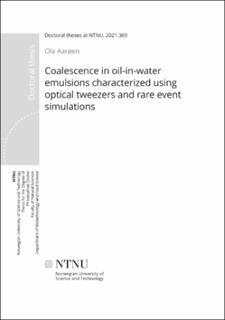| dc.contributor.advisor | Sletmoen, Marit | |
| dc.contributor.advisor | Riccardi, Enrico | |
| dc.contributor.author | Aarøen, Ola | |
| dc.date.accessioned | 2022-02-21T09:51:03Z | |
| dc.date.available | 2022-02-21T09:51:03Z | |
| dc.date.issued | 2021 | |
| dc.identifier.isbn | 978-82-326-6444-3 | |
| dc.identifier.issn | 2703-8084 | |
| dc.identifier.uri | https://hdl.handle.net/11250/2980416 | |
| dc.description.abstract | Emulsions are thermodynamically unstable systems comprised of two immiscible liquid phases, with one dispersed into the other as small droplets of varying size. Coalescence is a separation mechanism for emulsion systems, in which two droplets make contact, and merge into one. It is critical to the emulsion stability and transport processes involving emulsions. Previous experiments have shown that a main parameter that controls the dynamics of the coalescence event is interactions between interfacial layers surrounding the approaching droplets, in the liquid thin film that establishes between them. Additionally, the current state-of-the-art continuous models describe the interface region very crudely, without concern for the interactions that lead up to and facilitate coalescence.
The interactions leading up to and facilitating coalescence between oil-in-water emulsion droplets have been studied, using a combination of optical tweezers and molecular dynamics. Both pristine (un-stabilized) and (ionic surfactant) stabilized emulsion droplets were used, in separate experiments.
Studies with the pristine emulsions were focused on measuring the effects of approach velocity, and droplet size on the work of separation and the time of coalescence. Using optical tweezers allowed for exploring an area of droplet diameters rarely visited using other experimental techniques. And insight on ionic effects to the production, handling and use of emulsions in optical traps was therefore also obtained during this work as well.
Stabilized emulsions were used to explore the interactions of droplets with both ionic and surfactant presence, and how changing these two parameters affected depletion force and coalescence times. Experiments were combined with molecular dynamics simulations to clarify the dynamics of the thin film breakage, using model systems to represent the different stages of droplet interface approach. And this combination provided crucial explanations to the unexpected observed behavior leading up to film breakage in the optical tweezers. Specifically, they revealed how the solvated ions interacted with the ionic headgroups to change the stability of the thin film between droplet interfaces, and how the electrical double layer formed on interfaces was disrupted in steps leading up to coalescence.
Although the MD simulation scheme was crude, the work provides an excellent transition to a proper rare event simulation, using software that have been improved within this work as well. Improvements to already well-established rare event simulation software PyRETIS were also made. To the simulation scheme, this is done by the improvement of sampling efficiency, interfacing with external dynamics, and refining the phase space exploration by implementing new shooting moves and simulation initialization. Furthermore, the PyRETIS software gained a user-friendly post-processing and visualization package, PyVisA, answering the call for more accessible and customizable software to a wider user base. Functionalities of the PyRETIS–PyVisA combination include, but are not limited to, correlation of order parameters with other descriptors, identifying latent variables, interfacing with external molecular visualizer, and a variety of plotting tools that can aid in identifying possible meta-stable states. For a system as large as the ones used to model the thin film, these tools would unquestionably be of great value in analysing of the results, providing further insight into the effects of parameters to resulting film thickness and coalescence times. | |
| dc.language.iso | eng | en_US |
| dc.publisher | NTNU | en_US |
| dc.relation.ispartofseries | Doctoral theses at NTNU;2021:369 | |
| dc.relation.haspart | Paper 1:
Riccardi, Enrico; Lervik, Anders; Roet, Sander; Aarøen, Ola; van Erp, Titus Sebastiaan.
PyRETIS 2: An improbability drive for rare events. Journal of Computational Chemistry 2019 ;Volum 41.(4)
https://doi.org/10.1002/jcc.26112
This is an open access article under the terms of the Creative Commons Attribution License (CC BY 4.0) | |
| dc.relation.haspart | Paper 2:
Aarøen, Ola; Kiær, Henrik; Riccardi, Enrico.
PyVisA: Visualization and Analysis of path sampling trajectories. Journal of Computational Chemistry 2020 ;Volum 2021.(42) s. 435-446
https://doi.org/10.1002/jcc.26467 | |
| dc.relation.haspart | Paper 3:
Aarøen, Ola; Riccardi, Enrico; Sletmoen, Marit.
Exploring the effects of approach velocity on depletion force and coalescence in oil-in-water emulsions. RSC Advances 2021 ;Volum 11.(15) s. 8730-8740
DOI https://doi.org/10.1039/D1RA00661D
This is an open access article under the terms of the Creative Commons
Attribution-NonCommercial 3.0 Unported (CC BY-NC 3.0) | |
| dc.relation.haspart | Paper 4:
Aarøen, Ola; Riccardi, Enrico; van Erp, Titus Sebastiaan; Sletmoen, Marit.
Thin film breakage in oil–in–water emulsions, a multidisciplinary study. Colloids and Surfaces A: Physicochemical and Engineering Aspects 2022 ;Volum 632. s. 127808
https://doi.org/10.1016/j.colsurfa.2021.127808
This is an open access article under the terms of the Creative Commons Attribution License (CC BY 4.0) | |
| dc.title | Coalescence in oil-in-water emulsions characterized using optical tweezers and rare event simulations | en_US |
| dc.type | Doctoral thesis | en_US |
| dc.subject.nsi | VDP::Technology: 500::Food science and technology: 600 | en_US |
